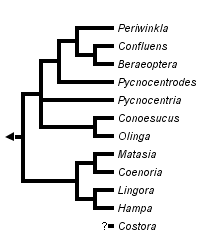Conoesucidae
Karl Kjer


This tree diagram shows the relationships between several groups of organisms.
The root of the current tree connects the organisms featured in this tree to their containing group and the rest of the Tree of Life. The basal branching point in the tree represents the ancestor of the other groups in the tree. This ancestor diversified over time into several descendent subgroups, which are represented as internal nodes and terminal taxa to the right.

You can click on the root to travel down the Tree of Life all the way to the root of all Life, and you can click on the names of descendent subgroups to travel up the Tree of Life all the way to individual species.
For more information on ToL tree formatting, please see Interpreting the Tree or Classification. To learn more about phylogenetic trees, please visit our Phylogenetic Biology pages.
close boxIntroduction
Ross (1967) established the subfamily Conoesucinae within the Sericostomatidae for Australasian genera with “atrophied” scutal warts, but he did not name the included genera or offer any other diagnosis. Later, Neboiss (1977) elevated the subfamily to family status, provided a detailed diagnosis, and included 6 Australasian genera in the family, all formerly included in the Sericostomatidae. Additional sericostomatid genera have been transferred to Conoesucidae such that the family now contains a dozen genera and ca. 40 species, endemic to either southeastern Australia and Tasmania (Coenoria Mosely, Conoesucus Mosely, Costora Mosely, Hampa Mosely, Lingora Mosely, Matasia Mosely) or New Zealand (Beraeoptera Mosely, Confluens Wise, Olinga McLachlan, Periwinkla McFarlane, Pycnocentria McLachlan, Pycnocentrodes Tillyard). (From Holzenthal et al., 2007a)Characteristics
The larvae live in small, cool, fast-flowing streams where they feed on leaf litter detritus, algae, and moss. Their cases are made of sand, small rocks, plant parts, or silk; cases are tubular and only slightly curved. Adult males have shortened, membranous maxillary palps that are held out in front of the face. Ward (1995) reported that adults of a New Zealand species of Pycnocentria were common and active during hot summer days on streamside sedges, herbs, and grasses. (From Holzenthal et al., 2007a)Discussion of Phylogenetic Relationships
Holzenthal et al. (2007b) strongly place the Coneosucidae within the Sericostomatoidea, but did not find strong evidence for its relative placement within the group. The monophyly, and the relationships among genera were examined by Johanson et al. (2009).References
Holzenthal R.W., Blahnik, R.J., Prather, A.L., and Kjer K.M. 2007a. Order Trichoptera Kirby 1813 (Insecta), Caddisflies. In: Zhang, Z.-Q., and Shear, W.A. (Eds). 2007 Linneaus Tercentenary: Progress in Invertebrate Taxonomy. Zootaxa. 58 pp. 1668:639-698
Holzenthal R.W., Blahnik, R.J., Kjer K.M and Prather, A.L. 2007b. An update on the phylogeny of Caddisflies (Trichoptera). Proceedings of the XIIth International Symposium on Trichoptera. Bueno-Soria, R. Barba-Alvearz and B. Armitage (Eds). pp. 143-153. The Caddis Press.
Johanson, K-A., Kjer, K.M., and Malm, T. (2009) Testing the monophyly of the New Zealand and Australian endemic family Conoesucidae Ross based on combined molecular and morphological data (Insecta: Trichoptera: Sericostomatoidea). Zoologica Scripta. 38: 563 - 573.
Neboiss, A. (1977) A taxonomic and zoogeographic study of Tasmanian caddis flies (Insecta: Trichoptera). Memoirs of the National Museum of Victoria, 38, 1–208, plates 1–3.
Ross, H.H. (1967) The evolution and past dispersal of the Trichoptera. Annual Review of Entomology, 12, 169–206.
Ward, J.B. (1995) Nine new species of New Zealand caddis (Trichoptera). New Zealand Journal of Zoology, 22, 91–103.
About This Page
Karl Kjer

Rutgers University, New Brunswick, New Jersey, USA
Correspondence regarding this page should be directed to Karl Kjer at
Page copyright © 2010 Karl Kjer
 Page: Tree of Life
Conoesucidae.
Authored by
Karl Kjer.
The TEXT of this page is licensed under the
Creative Commons Attribution-NonCommercial License - Version 3.0. Note that images and other media
featured on this page are each governed by their own license, and they may or may not be available
for reuse. Click on an image or a media link to access the media data window, which provides the
relevant licensing information. For the general terms and conditions of ToL material reuse and
redistribution, please see the Tree of Life Copyright
Policies.
Page: Tree of Life
Conoesucidae.
Authored by
Karl Kjer.
The TEXT of this page is licensed under the
Creative Commons Attribution-NonCommercial License - Version 3.0. Note that images and other media
featured on this page are each governed by their own license, and they may or may not be available
for reuse. Click on an image or a media link to access the media data window, which provides the
relevant licensing information. For the general terms and conditions of ToL material reuse and
redistribution, please see the Tree of Life Copyright
Policies.
- First online 17 July 2010
- Content changed 20 July 2010
Citing this page:
Kjer, Karl. 2010. Conoesucidae. Version 20 July 2010 (under construction). http://tolweb.org/Conoesucidae/14634/2010.07.20 in The Tree of Life Web Project, http://tolweb.org/





 Go to quick links
Go to quick search
Go to navigation for this section of the ToL site
Go to detailed links for the ToL site
Go to quick links
Go to quick search
Go to navigation for this section of the ToL site
Go to detailed links for the ToL site